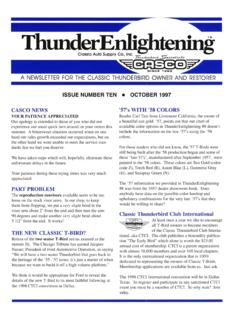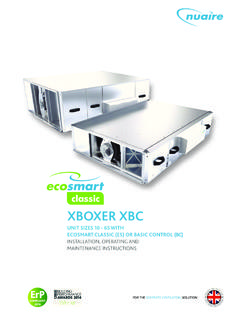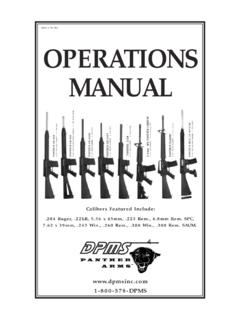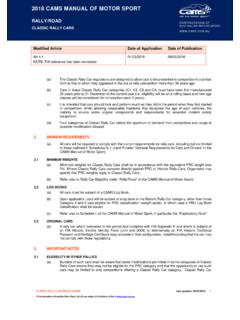Transcription of British Classic Motors
1 1 British Classic Motors Installation Guide Setting up Your Twin SU Carburetors Your carburettors have been set up, flow-bench tested, balanced, leak-tested, and all adjustments set to the original factory specifications, and settings. The only adjustments which should be necessary, are the idle speed, and final fuel mixture to suit your vehicle. These notes are designed to help you through the installation process. PLEASE remember to fill the suction chambers with the oil provided, to within of the top of the hollow piston rod, as shown in the diagram below. Before you install your carburetors, be sure to check that your plugs, points, and timing are set correctly before you do anything else. Many problems blamed on the carburetors are actually the result of ignition, or engine problems. When you are sure that all the above steps have been checked, let s get down to setting up your new carbs.
2 NOTE: Depending on your actual set up, some of these initial steps may not be required. Be sure to use new gaskets between the inlet manifold, heat-shield (if fitted) and the carburetors. For a twin carb set-up with a heat-shield you will need a total of 6, plus 2 for the air cleaners. With the carbs installed, hook up your accelerator, and choke cables, being sure to remove all slack from the inner cable by pulling the inner cable before tightening the fittings. With the choke cable, pull the choke knob on your dashboard out about before the tightening the fitting. Check that both cables operate smoothly before proceeding. Be sure also that both the throttle, and choke return springs are in place. Re-connect all the vacuum lines: distributor advance, brake booster (if fitted), and any other lines that may be present. Ensure that there are no vacuum fittings either on the carbs themselves, or on the inlet manifold that have nothing attached.
3 Any leaks here will prevent you from setting up the carbs correctly. Re-connect any evaporative loss / breather hoses that connect to your carburettors. The actual position and layout of these will depend on the type of carburettors, and the vehicle. If you are not sure, check your owner s manual. Ensure your fuel filter is in good condition, and replace it if necessary. Re-connect the fuel line from your filter, to the carburetor. New hose clamps are always recommended. Now, switch on the ignition, without starting the car. If your vehicle has an electric fuel pump, it should tick quite quickly for a few seconds as it fills the float chambers for the first time, and then slow down to an occasional tick. A mechanical pump will of course require the engine to be turned over to fill the float bowls. Check for any leaks, and if none are found turn off the ignition. Once you are satisfied that everything is correctly connected, it s time to start the car.
4 IMPORTANT: Do not fit your air cleaners yet, and DO NOT tighten the throttle linkage that connects the two carbs; it's important that each carburetor is able to operate independently of the other during the set up process. The following steps use the H/HS-Series carburettors as the example, and where there is a difference with the HIF model, this is referred to in the text. For HD Series carbs, please refer to page 3 of this document. 2 Setting up Your Twin SU Carburetors (continued) The Tune-Up It may well be that the settings we used when bench testing the carbs are fine for your vehicle, so, before we go any further let s just test them. First, bring the engine up to normal operating temperature. Once it s warm, if the idle is either too slow, or too fast, adjust the idle screws on both carbs by the same amount, to bring the idle close to normal speed. We will make the final adjustment to this later.
5 Using either the piston lifting pin (if fitted) or a narrow bladed screwdriver, lift one of the carburetor pistons about 1/32 and observe the change in engine speed. If the engine tends to die, the mixture is too weak, if it speeds up, the mixture is too rich. When the mixture is correct, the engine will speed up slightly, and then settle down to an even, but slightly higher speed. If one, or both, carbs are either weak, or rich, proceed to step 1) below. If they are both OK, then proceed straight to step 2). 1) Now for the fuel/air mixture. Raise the jet adjusting nut, on one carburetor at a time, until the engine speed just begins to fall off. Now, lower the jet adjusting nut until the engine speed begins to rise again, and then raise it again just 1/6 turn (one flat of the nut). HIF NOTE: Raise or lower the jet by using the mixture screw on the side of the carb. Screw in for a richer mixture, out for a weaker mixture.
6 IMPORTANT: Between each adjustment, rev the engine briefly to about 2000 rpm to clear out the carbs, before changing the setting. 2) When you have set the mixtures on both carbs, re-adjust idle to factory specifications, or where you prefer it. 3) Now, although we balanced the carbs before they were shipped, any idle speed adjustments that you have made, may have taken them out of balance again, so it s best to check. You can synchronize the carburetors using either a balancing device, such as a Unisyn, or a length of fuel, or similar, hose. Hold one end of the hose just in front of the carburetor inlet and listen to the 'hiss' of the air as it enters the carb. It is easy to notice any difference in airflow by the intensity of the 'hiss'. It is best to reduce the idle speed of the 'faster' carb and increase the idle speed of the 'slower' carb until both produce the same 'hiss'. Then, evenly adjust both idle speed screws to reach the desired idle speed.
7 You are almost done! 4) Pull the choke out until the jets are just at the point of moving but have not yet moved. Screw both the fast-idle screws in until they just touch the fast idle cam(s). Then, turn each fast idle screw until the idle speed is increased to about 1,000 RPM with the engine warm. Push the choke back in. 5) Finally, tighten the ends of the interconnecting linkage, adjusting each end if necessary to ensure that both carburetors move at the same time, when you pull on the throttle linkage, or cable. 6) Re-fit your air cleaners, and check to make sure you have removed all your tools from the engine compartment. Congratulations, now you're done! Take a test drive, and enjoy the experience of a rebuilt, and correctly set up pair of SU carburetors. 3 Setting up Your HD-Series (Twin & Triple sets) These require a different approach to the H, HS, and HIF series, due to significant design differences.
8 Note: On most vehicle applications (Aston Martin is one exception) the idle is controlled by the slow-running valve (shown as #1 in illustration on left), and this alone must be used to adjust the idling speed. IMPORTANT: It is imperative that the throttle linkage is allowing the butterflies to close completely. If not, it will not be possible to set the idle speed accurately. Return springs do not last forever and are often a major cause of linkages holding carbs open. Check that the entire linkage is operating smoothly, and is totally free. If you have changed the position of the volume screw, as a starting point screw down the slow-running and then unscrew turns. (1) Slacken a clamping bolt on one of the throttle spindle interconnection couplings between the carburetors. This ensures that the carbs will be set-up independently of each other. NOTE: On some vehicles, of which the Jaguar E-Type is one, there is not an interconnection coupling; the throttle linkage connects to the individual throttle levers, and in these cases, leave them disconnected while the carbs are being set up.
9 (2) Disconnect (or leave disconnected) the choke control rods, until the mixture, and idle, has been set. (3) Restart the engine and turn the slow-running valve (1), or the throttle adjusting screw, an equal amount on each carb to give the desired idling speed. (4) Compare the intensity of the intake hiss on all carbs and alter the slow-running valves, or throttle adjusting screws, until each hiss is the same. Use either a balancing device, or a piece of tubing. (5) Check the mixture by raising the lifting pin of the front carb 1/32 after free movement has been taken up. Lower the jet for a richer mixture by screwing the mixture screw down (shown as 3 in illustration above), and unscrew to raise (weaken) the mixture. Please refer to the Tune-Up notes earlier in this document to check the mixture. (6) Repeat the operation on the other carb(s) and after adjustment re-check the settings as the carbs are still operating interdependently.
10 (7) Tighten the clamp bolt of the throttle spindle interconnections with the pin of the link pin lever resting against the edge of the pick-up lever hole. This provides the correct delay in opening the front carb throttle. When forked levers are fitted, set the cranked levers so that the pin is from the lower edge of the fork. (8) Reconnect the choke control linkage so that the jet operating arms move simultaneously; if necessary, turn the fork end(s). Reconnect the mixture control wire with about 1/16 free movement before it starts to pull on the jet levers. (9) Pull the mixture control knob until the linkage is about to move the choke operating arms, and then adjust the fast-idle screws (FI in above image) to give an engine speed of about 1,000 rpm when hot. (10) Return the control knob and check that there is turn of clearance between the fast idle screws and the throttle stops.







